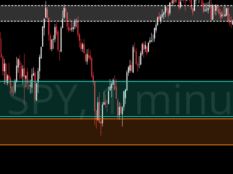The Wild Ride of Day Trading:
Day trading involves buying and selling stocks within the same trading day, aiming to make a profit from short-term price movements. It's like a roller coaster ride, where you're desperately trying to predict price shifts minutes or even seconds before they happen. It's a game of technical analysis, trying to figure out when the stock will hit its high or low point. And let's not forget the adrenaline rush of being in and out of positions faster than Leonardo DiCaprio leaves a relationship once the woman he's dating hits age 25.

Trading Plans For Day Traders, Jedi Mind Tricks and Pen-to-Paper Magic:
Day trading requires careful planning and discipline. You can't just wake up and randomly start trading like a cat chasing a laser pointer. You need a solid trading plan, one that involves asking yourself important questions every single day. What are your criteria for today's trades? What strategies are you planning to implement? How volatile is the market? And yes, my friend, you need to write it down! Putting pen to paper not only helps you retain information better, but it also serves as a reminder to stay focused and avoid going off the rails when things get crazy.
See how you can form the Perfect Trading Plan to become a True Jedi in the Market: https://youtu.be/JO_xAYYNedE

Direct Market Access, Avoiding the Middlemen (and Women):
Trading fees may have vanished with the rise of commission-free brokers, but there's still a catch. Many brokers sell order flow to market makers, who then decide where to send each order. As a day trader, you need speed, accuracy, and control over your orders. Enter direct market access (DMA) brokers. They give you the power to dictate exactly where and when your orders are executed. It's like having a VIP pass to the trading floor, where you can cut through the noise and make your moves with precision.
Stock Scanner, Finding the Needle in the Market Haystack:
When you're day trading, you're trying to find that perfect needle in the haystack of stocks. But let's face it, your eyeballs alone won't cut it. That's where a stock scanner comes in. It's not your average stock screener; it's a magical tool that narrows down the thousands of options to a handful of potential winners. It's like having a personal assistant who whispers in your ear, "Hey, check out these opportunities!" Who needs luck when you have a stock scanner by your side? We go over Day Trader Stock Screener Settings in our Trading University over in our Discord!! https://discord.gg/pennybois
Volatility, The Spice of Day Trading Life:
You know those days at work when you can't get anything done? The ones where everything feels stagnant, and you'd rather be anywhere else? Well, day traders can't escape those moments. Day trading thrives on volatility. If the stocks aren't moving, you're not making money. So, brace yourself for those days when the market decides to take a siesta. It's all about discipline and not forcing trades when the opportunities just aren't there. And hey, on those slow days, you can always take a break, run errands, or simply revel in the fact that you don't have to wait until 5 pm to leave work. Freedom, baby!

Now that we've covered the essentials, let's talk about what it takes to become a successful day trader:
Education is key, my friend. You can't just rely on your gut feeling or a lucky rabbit's foot. You need to learn the ropes and develop a solid understanding of the strategies involved. Momentum trading, gap and go trading, bull flag trading—these are just a few techniques that can lead you to victory. Pick your favorites, create a trading plan, and stick to it like glue.
Practice Makes Perfect:
Lebron James didn't become one of the greatest NBA player of his generation by just showing up to games. He put in the hours, took thousands of shots, and sought advice to improve. As a day trader, you need that same level of dedication. Practice is crucial, and that's why paper trading exists. It's like a virtual playground where you can test strategies, make mistakes, and refine your skills—all without risking a single penny of real capital. So, practice, practice, and practice some more until you find what works best for you. Just don't forget to take off those virtual trading training wheels when you're ready for the real deal.
Scaling Up, From Simulated Success to Live Trading:
Paper trading can make you feel like a trading wizard, racking up gains left and right. But when you switch to live trading, it's a whole different ball game. Start small, my friend, and scale up gradually. Keep your profit goals in line with your simulator sessions, and don't let your emotions take control. Small wins are the name of the game, as they keep you disciplined and on track. And hey, remember that consistency is the true secret to day trading success. So, stay focused, keep your position sizes in check, and don't let Mr. Market bring you down.
Capital Requirements, A $25,000 Necessity:
Before you embark on your day trading adventure, you need to meet certain capital requirements. The Securities and Exchange Commission (SEC) and the Financial Industry Regulatory Authority (FINRA) have set a minimum equity rule for "pattern day traders." Unless you have a whopping $25,000 in your brokerage account, you're limited to only three day trades in a rolling 5-day period. That means you can't unleash your inner trading ninja unless you've got the cash to back it up. Time to start saving those pennies! Unless of course you use a Cash Account (see below).
Day Trading with a Cash Account, The Underdog's Route:
So typically day trading requires a minimum account balance of $25,000 to be classified as a pattern day trader. While this rule applies to margin accounts (where traders can borrow funds from their brokers), there is another route for those with smaller account sizes: day trading with a cash account.
A cash account is a type of brokerage account where you can only trade using the cash available in the account, without the option to borrow on margin. This means you won't have access to leverage, but it also means you won't be subject to the pattern day trading rule. So, if you have less than $25,000 and still want to engage in day trading, a cash account is your ticket to the game.
Trading Restrictions and Settlement Periods With Cash Accounts:
Trading with a cash account comes with its own set of limitations. One key restriction is the settlement period. When you buy or sell a stock, there is a settlement period during which you must wait for the funds to fully settle before you can use them for another trade. In the United States, this period is typically two business days (T+2). Therefore, if you sell a stock, you won't have access to those funds until the settlement period is over.
Trading within these settlement restrictions requires careful planning and consideration. It means you can't execute unlimited trades within a single day like you could with a margin account. Each trade you make will tie up your capital until the settlement period is complete, limiting the number of trades you can make within a specific timeframe.
Strategies for Day Trading with a Cash Account: To optimize your day trading with a cash account, you'll need to employ different strategies compared to margin traders. Here are a few strategies that can work well with smaller account sizes:
- Focus on high-quality setups: With limited capital, it's crucial to be selective in your trades. Look for high-probability setups that align with your trading plan and have the potential for significant moves. Avoid chasing after every opportunity and instead wait for the best setups that give you a higher probability of success.
- Scaling in and out of positions: With a cash account, you can scale in and out of positions by gradually building or reducing your position size. This approach allows you to manage risk effectively and make the most of your available capital. By scaling in and out, you can still take advantage of short-term price movements while adhering to settlement restrictions.
- Focus on low-cost stocks: Since you won't have access to margin and leverage, it can be beneficial to focus on lower-priced stocks. These stocks often require less capital to trade, allowing you to diversify your positions and increase the number of opportunities available to you.
Remember, day trading with a cash account requires a disciplined approach due to the limitations imposed by settlement periods. It's essential to plan your trades carefully, manage risk effectively, and make the most of the opportunities that fit within the constraints of your account size. So, if you're willing to put in the effort and stay disciplined, even the underdog can find success in the exciting world of day trading.
Wrap Up:
Day trading is not for the faint of heart, my fellow adventurers. It requires capital, education, practice, and a healthy dose of humor. The pros may make it look easy, but the reality is far from it. So, if you're ready to ditch that desk job and embark on a day trading journey, buckle up and get ready for the ride. Educate yourself, practice diligently, and keep a sense of humor intact. Happy trading, my friends!



